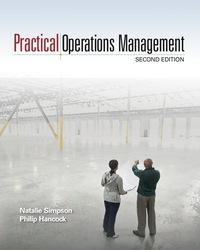Question
Consider a city that conforms to the assumptions of the basic monocentric city urban model studied in class, with one key difference. The difference is
Consider a city that conforms to the assumptions of the basic monocentric city urban model studied in class, with one key difference. The difference is that the urban residents experience crime, which varies in intensity across the city. The level of crime, as measured by the probability of being robbed on the street, is highest at the CBD. The probability of being robbed falls gradually as distance from the CBD increases, and it reaches zero at x = 5 miles out from the CBD. From this location out to the city boundary (which lies x = 10 miles from the CBD), the neighborhoods are crime free. As usual, moving farther from the CBD raises commuting cost, regardless of whether a resident lives inside or outside of the crime area.
(a) Draw a graph to represent the probability of crime (y-axis) as a function of distance x from the CBD (x-axis). Clearly indicate x = 5 and x = 10 on the graph.
(b) Under the above assumptions, analyze the spatial behavior of the price per square foot of housing in the city. For your analysis, provide explanations along with graphs showing the price per square foot of housing (p) as a function of distance to the CBD (x). These graphs are not based on precise equations, they merely represent the direction (upward or downward) and slope (relative steepness or flatness) of the curve, while paying special attention to changes that may/may not happen at x = 5. Consider the following three different possible cases (draw one separate graph for each possible case). (i) Urban residents have a very strong aversion to crime (so that the effect of aversion to crime dominates the effect of aversion to commute-distance). (ii) Urban residents have only a moderate aversion to crime (so that the effect of aversion to commute-distance dominates the effect of aversion to crime). (iii) Urban residents don't care at all about crime (hence, there is no effect of crime on decision making).
(c) Using your answer from (b) along with reasoning from class, analyze the spatial pattern of land rents and building heights in the city. Carry out this analysis only for case (i), where residents have a strong aversion to crime. Along with the explanation, draw two separate graphs, one showing the pattern of land rents (r) and the other showing the pattern of building heights (b), both as a function of distance to the CBD (x). Hint: pay special attention to what happens at x = 5.
Now consider that this city consists of two-income groups "rich" (R) and "poor" (P) with no difference in the cost of commuting for these two groups. The rich residents have a very strong aversion to crime (the effect of aversion to crime dominates the effect of aversion to commutedistance) while the poor residents are moderately averse to crime (the effect of aversion to commute-distance dominates the effect of aversion to crime).
(d) For this scenario, on the same graph, draw and explain the economic behavior of prices per square foot of housing for the rich and the poor (pR and pP) as a function of distance to the CBD (x). Again, these graphs are not based on precise equations, they merely represent the direction (upward or downward) and slope (relative steepness or flatness) of the curve, while paying attention to changes that may/may not happen at x = 5.
(e) Based on your graphs from part (d), what would be the equilibrium spatial distribution of rich and poor residents in this city - i.e. at what locations would the rich and poor residents of this city live with reference to the CBD? Why?
f) The local city government decides to clean up crime in this city with the intention of improving lives of the poor residents. The city government succeeds and the city is completely crime-free (same as basic the monocentric city model but with rich and poor residents). Does this policy really improve the lives of the poor residents? If yes, then how? If no, then why not? [Hint: There isn't one correct answer here. I am looking for how you use economic intuition in developing a response.]
Step by Step Solution
There are 3 Steps involved in it
Step: 1

Get Instant Access to Expert-Tailored Solutions
See step-by-step solutions with expert insights and AI powered tools for academic success
Step: 2

Step: 3

Ace Your Homework with AI
Get the answers you need in no time with our AI-driven, step-by-step assistance
Get Started


